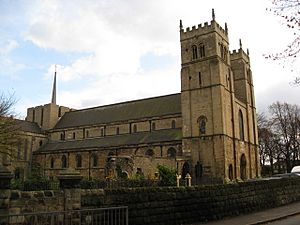Worksop Priory facts for kids
Quick facts for kids Worksop Priory |
|
|---|---|
| The Priory Church of Our Lady and St Cuthbert | |

Worksop Priory
|
|
| Denomination | Church of England |
| Churchmanship | Anglo Catholic |
| History | |
| Dedication | Our Lady and St. Cuthbert |
| Administration | |
| Parish | Worksop Priory |
| Archdeaconry | Newark |
| Diocese | Southwell and Nottingham |
| Province | York |
Worksop Priory is a very old and special church in the town of Worksop, Nottinghamshire, England. Its full name is the Priory Church of Our Lady and Saint Cuthbert. It's part of the Church of England and used to be a priory, which is a type of monastery where monks lived and worshipped.
This church is considered a very important building because of its history and amazing architecture. It's so important that it's called a Grade I listed building. This means it's one of the most significant historic buildings in England!
Contents
History of Worksop Priory
The story of Worksop Priory began a very long time ago, in 1103. A man named William de Lovetot gave land and money to start an Augustinian priory here. Augustinians were a group of monks who lived and worshipped together.
Over the years, the priory became a place where important books were made. For example, in 1187, the Worksop Bestiary was given to the priory. This was a beautiful book with drawings of animals, and it's now in a museum in New York! Later, in the 14th century, the Tickhill Psalter was created by the prior (the head of the priory), John de Tickhill.
The Priory Changes Hands
The priory continued until 1539. At that time, Henry VIII was the King of England, and he ordered many monasteries to close down. This event is known as the Dissolution of the Monasteries. Worksop Priory was closed on November 15, 1539.
After it closed, the priory was given to Francis Talbot, 5th Earl of Shrewsbury. There was a special condition: the Earl had to provide a glove for the King or Queen's right hand at their coronation! This unique tradition still continues today.
Over time, many of the old monastic buildings were taken apart for their stone. But luckily, the main part of the church (called the nave) was saved. It became the local parish church for the people of Worksop. The old gatehouse from the 14th century was also saved and used as a school.
Restoring the Church
In the mid-1800s, a lot of work began to fix up and make the church bigger. These restoration efforts continued through the 1900s.
In 2017, during some renovation work, a carved face was found on one of the priory walls. Experts think the face might be from around 980 AD, even though the wall itself was built around 1260 AD. It's a mystery how it got there!
Repairs and Improvements Over Time
Worksop Priory has been cared for and improved many times throughout its long history. Here are some of the key moments:
- In 1760 and 1784, wooden galleries were added inside the church.
- From 1845 to 1849, a big restoration project took place. The church got a new roof, and parts of the building were made strong again.
- In 1879, a new organ was installed.
- In 1883, the south tower was repaired, and two new bells were added, making a total of eight bells.
- The old gatehouse was restored in 1912.
- In 1922, the Lady Chapel was restored and rededicated.
- More building work happened in the 1930s, including opening up parts of the church and adding a turret to the central tower.
- In 1974, a new choir area was built, and another new organ was installed.
Important People Buried Here
Some notable people are buried at Worksop Priory:
- William de Lovetot: The person who first gave the land and money to start the priory.
- John Talbot, 3rd Earl of Shrewsbury: Buried in the Lady Chapel.
The Priory Organ
Worksop Priory has a very special organ. The beautiful wooden case for the organ was designed by Peter Collins. It's made from mahogany and pine. The case isn't just for looks; it helps mix the sound from the pipes and send it out into the church.
The organ has 1634 pipes! These pipes are made from different materials, including tin, copper, and pine. Most of the pipes you see at the front of the organ actually make sound. Some parts of the organ, like the reed pipes and the cymbelstern (a bell-like sound effect), come from Germany and Holland.
The part of the organ where the player sits is made of oak. The keys are made of a hard, dark wood, and the white keys are topped with resin. The organ has 56 keys for the hands and 30 keys for the feet.
This organ was built with ideas from the 17th and 18th centuries, which gives it a unique sound compared to many other organs in England. It's designed to project its sound powerfully throughout the priory.
In 1996, the organ was rebuilt and improved. It was cleaned, and parts were renewed to make sure it sounds its best.
Images for kids
-
Engraving form John Stevens' The History of the Antient Abbeys, 1723







